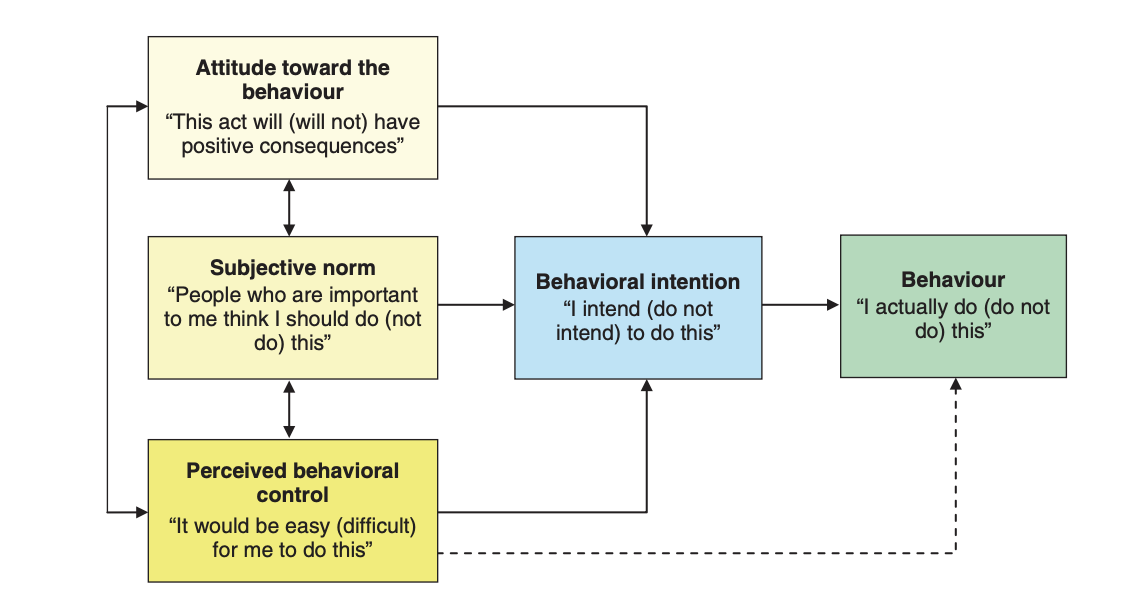The Green Gap
Although there is robust scientific consensus around the existence of anthropogenic climate change, pro-environmental action lags across various sectors such as health, government, academics, and business.4 At present, the severity of climate change and ecosystem disruption has also garnered wide acceptance by the general public; however, many people have yet to adopt sustainable, adaptive, and resilience-oriented practices.5 This phenomenon is referred to as the ‘green gap’ – a situation in which environmental concerns and values do not translate into pro-environmental behaviour.6 While it may have once been assumed that knowledge dissemination of new data would motivate people to change their attitudes and actions, it is clear that the mechanisms underlying behaviour are more complex and influenced by a diverse range of factors.
Various theoretical frameworks have been applied to understand and conceptualize the psychological dissonance between environmental intention and climate change action. With the support of these tools, scientists, climate experts, psychologists, and policy-makers have the capacity to develop implementation strategies aimed towards transforming pro-environmental values and intention into meaningful action.5 The application of Bandura’s social cognitive theory and Ajzen’s theory of planned behaviour to climate-related behaviour is introduced below.
Social Cognitive Theory

Bandura’s social cognitive theory has been widely utilized in the literature to examine the engagement of climate change action or lack of action.23,24 Self-efficacy, which refers to one’s belief in their ability to execute a certain behaviour, has been identified as one of the most important predictors of behaviour change. This is because attitudes towards self-efficacy determine whether actions will be initiated, the amount of effort required, and the extent to which actions will be sustained in the face of challenges.7,8 As such, it has been implemented in behaviour change interventions in four ways: having successful personal experiences of the task or behaviour; seeing others perform successfully; hearing others profess their faith in one’s abilities; and being in a non-anxious physiological state, all of which contribute to more positive appraisals of one’s capabilities.23 As such, self-efficacy serves as an important tool that could be utilized to tackle large-scale social issues, including climate change, as it determines whether the individual believes they have the ability to contribute to meaningfully mitigating this crisis.2,9
Outcome expectancy is another component of social cognitive theory that holds particular relevance to climate action.23 It is defined as an individual’s confidence in the extent to which their actions will effectively protect against climate change.24 When acting in parallel, high efficacy beliefs coupled with positive outcome expectancies are expected to lead to action, productive engagement, and personal satisfaction.23 On the other hand, low efficacy beliefs combined with low outcome expectancies generally lead to inaction and the belief that no amount of effort will produce the desired outcomes.23
Theory of Planned Behaviour (TPB)
Another prominent model that has been used to explain the association between pro-environmental attitudes and engagement of pro-environmental action is the theory of planned behaviour (TPB).5 It postulates that any behaviour (i.e., climate action) is directly influenced by an individual’s psychological intention to engage in that behaviour. This component is termed behavioural intention and is shaped by three key factors: the individual’s attitude towards the behaviour, the perceived social norms surrounding the behaviour, and the degree of perceived control or self-efficacy one has over the behaviour.10 Research has demonstrated that the TPB can be applied to describe the individual engagement of environmental practices, including the use of public transport, environmentally conscious consumption habits, energy conservation, and recycling.5,6

Identification of and efforts to address the causes of the “Green Gap” – the space between intention and action – are required with regard to adopting sustainable, adaptive, and resilience-oriented practices in the face of climate change
Blaine Grinder discusses the importance of Indigenous involvement in green initiatives and how the next generation is paying for the greed of the generation before us (1:07)

